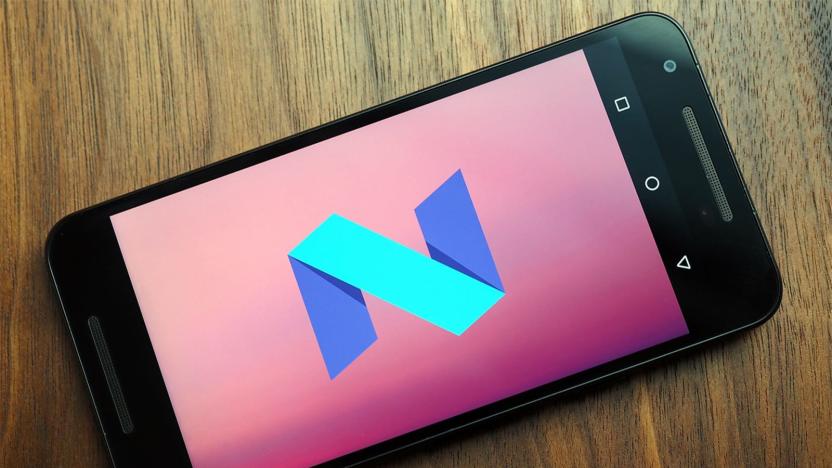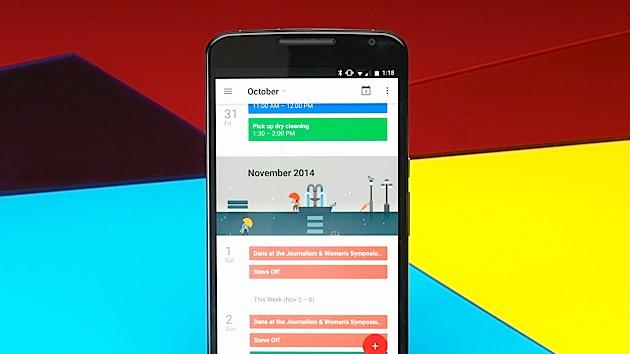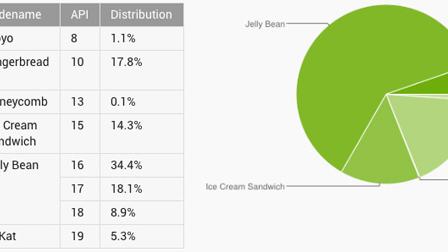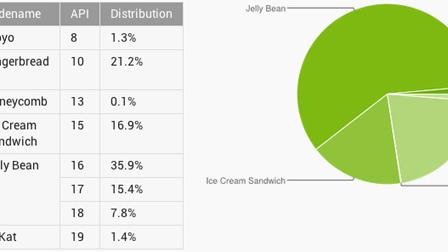androidversion
Latest

Nougat is now the most-used version of Android, 17 months later
Google hasn't quite licked its problems getting users to adopt the latest version of Android. Its latest Play Store user share stats show that Nougat has become the most-used Android release at 28.5 percent... just over 17 months after its summer 2016 debut. Not exactly a speedy transition, then. That still gives it the edge over the older-still Marshmallow release, mind you, and indicates that a large chunk of the user base is running a modern take on Android.

Marshmallow is now on 10 percent of Android devices
The latest version of Android just hit a big, big milestone. Google's early June developer stats have revealed that Marshmallow is now on just over 10 percent of Android devices, representing a huge jump from just 2.3 percent in March. Notably, only some of that surge can be credited to people upgrading from Lollipop. While the not-quite-current version's adoption did go down (to 35.4 percent), the biggest declines in usage were for Jelly Bean and KitKat. In essence: many of those moving to Marshmallow may well have been replacing devices that were 3 or more years old.

Lollipop becomes the most popular version of Android
At last, there's a new flavor of Android on top of the heap. Google has published updated stats which show that Lollipop is now the most-used version of Android, snagging 36.1 percent of device share in early March versus former champ KitKat's 34.3 percent. It's a big milestone that suggests many Android users are using a reasonably modern take on the mobile platform.

Nearly a quarter of Android users are running Lollipop
Android Lollipop is enjoying its last, shining moment in the sun before Marshmallow arrives in earnest. Google's not-quite-current operating system now accounts for 23.5 percent of active Android users, a healthy 2.5-point boost from what you saw just one month ago. That's still trailing behind Jelly Bean (30.2 percent) and KitKat (38.9 percent), but it's clear that all those new devices and upgrades are starting to add up. The real question is whether or not that momentum will last. Marshmallow is arriving relatively quickly, and shouldn't suffer from the early performance and battery life woes that kept some people from upgrading last year. If the newer release catches on quickly, Lollipop might not reach the lofty adoption rates of its predecessors.

Android Lollipop is slowly (very slowly) hitting more devices
Lollipop didn't exactly take the Android world by storm when it first launched. Early adoption was slow enough that it made no real impact in usage share stats for the first couple of months. People are starting to take to Google's latest dessert-flavored OS, however -- it's finally on the official radar. Google's data now shows that about 1.6 percent of active Android users were using Lollipop as of the start of February. That's certainly not a lot, but it's clear that all those Nexuses and early Lollipop upgrades (most notably from HTC, LG and Motorola) count for something.

Lollipop isn't making a dent in Android usage numbers (yet)
Now that Android 5.0 Lollipop is finally rolling out to devices around the globe, you might be wondering just how much of an impact it's making on the Android ecosystem. The short answer: not much. Google has released its latest Android usage stats, and Lollipop doesn't even register yet -- in other words, less than 0.1 percent of Google Play users have moved to the new software. That's not surprising given that both the upgrade and Lollipop-native devices like the Nexus 6 are weeks old at best, but it suggests that the new OS will take a while before it makes its presence known.

KitKat is now running on more than 20 percent of Android devices
In case there was any doubt that KitKat now has a solid foothold in the Android world, Google just offered some proof. Its usage data for early August shows that KitKat is on more than a fifth of active Android devices, at 20.9 percent. That's a healthy improvement over July (17.9 percent), and a big leap over the 14.9 percent we saw in June. The folks in Mountain View aren't explaining the steady growth, but it's easy to figure out what's going on -- big-name devices like the LG G3 and Samsung Galaxy Tab S are bringing this latest OS flavor to a wider audience, and many older gadgets are still getting upgrades.

KitKat is now on nearly 14 percent of Android devices
You know how Apple was keen to point out that only 9 percent of Android users (technically, 8.5 percent) were running KitKat in May? Well, that figure's now out of date. Google has published fresh usage stats which show that 13.6 percent of Android owners are using KitKat as of early June. That's still far from a majority, but it represents a 60 percent jump in a single month. It's not hard to see why the newer OS would be making such big strides. Major new phones like the HTC One and Galaxy S5 have had more time on the market, and KitKat upgrades are still making their way to older gadgets.

KitKat's share of Android devices more than doubles to 5.3 percent
After months of treading water, Android 4.4 KitKat is finally taking off. Google reports that 5.3 percent of Android users are running the newer OS version as of early April; that's more than twice the 2.5 percent that it claimed one month earlier. There's no official explanation for the jump, but it's most likely thanks to a wave of KitKat upgrades from HTC, LG and Samsung. Most older versions lost share as a result. It could be a long, long time before KitKat overtakes Jelly Bean (which dipped to 61.4 percent), but the transition is under way -- and it's only likely to accelerate now that flagships like the Galaxy S5 and new One are reaching store shelves.

Jelly Bean claims 59.1 percent of Android device share as KitKat inches forward
Google has released its first Android device share data for 2014, and it's now clear that many users are flocking to a newer OS version... just not the latest version. While the shiny new KitKat release did climb to 1.4 percent of active devices in January, Jelly Bean was the real winner -- the older software jumped from 54.5 percent in December to 59.1 percent this month. There's no real mystery as to what happened, though. KitKat remains limited to mostly Google hardware, whether it's the Nexus line or Motorola phones; we haven't quite reached that point where large numbers of third-party devices either get KitKat upgrades or ship with the revision pre-installed. That surge may come soon, however, and the team in Mountain View can at least take comfort in knowing that over 60 percent of Android's active customer base is reasonably up to speed.

KitKat claims 1.1 percent of Android device share a month after launch
KitKat may be the new kid on the Android block, but it's already faring quite well. Google's latest OS dashboard reveals that 1.1 percent of active Android devices are running the new platform roughly a month after it became available. Not that its arrival is slowing down Jelly Bean's growth, mind you. The older software now represents 54.5 percent of all Android use, thanks in part to a two-point surge in devices running Android 4.3. However well Jelly Bean is doing, we expect KitKat adoption to rise quickly -- both the Nexus 5 and the first official KitKat upgrades have only been around for a few weeks at most, and there are more updates on the way.

More than half of Android devices now run Jelly Bean
It may have taken almost a year and a half, but Google can at last say that the absolute majority of active Android devices are using some form of Jelly Bean. The company's OS dashboard shows that 52.1 percent of owners are running at least Android 4.1; most of those (37.3 percent of the total) rely on the oldest version, but Android 4.2's use has already doubled since August. Jelly Bean's reign may be short-lived, however. The milestone comes just as Android 4.4 KitKat is reaching the public -- given Google's focus on supporting as many devices as possible with the new OS, it may not be long before Jelly Bean is once again in the minority.

More than 40 percent of active Android devices now run Jelly Bean, Gingerbread stubbornly holds steady
The last time Google visited Jelly Bean's user saturation numbers, it took the combined efforts of 4.1 and 4.2 to edge out Gingerbread's (v2.3.3 through 2.3.7) hold on the user base. Not anymore; the latest numbers from the Android Dashboard show the base version of Jelly Bean, Android 4.1, representing 34 percent of the active devices -- singlehandedly surpassing the old guard's 33 percent share of the market. When combined with the rest of the Jelly Bean contingent (Android 4.2 and above), Google's latest flavor of Android crushes Gingerbread with a 40.5 percent majority. Froyo (v2.2), Eclair (v2.1) and Ice Cream Sandwich (v4.0.3 through 4.0.4) all took modest hits as well, though the latter of the trio retained its third-place position with 22.5 percent of active users. The only builds to hold steady? Honeycomb (v3.2) and Donut (v1.6), each retaining a miniscule 0.1 percent of the market. We'll admit, it's cute to see these old versions hang on, but please -- if you're still rocking a handset running Android 1.6, do us all a favor and turn it off.

Jelly Bean now on 33 percent of active Android devices, Gingerbread still leads
Google's pushed out its latest survey of the Android landscape, and Jelly Bean is finally creeping up on Gingerbread for the crown. While Gingerbread accounts for 36.5 percent of active devices sporting Mountain View's OS, versions 4.1 and 4.2 stand just behind with a total of 33 percent, up 4.6 percent since last month. Ice Cream Sandwich is helping itself to 25.6 percent of the statistic pie, while Froyo, Eclair and Donut each trail behind with less than five percent combined. Now that Jelly Bean is within a 3.5 percent striking distance of the top spot, this may be the last time we see Gingerbread in the lead.

ICS now on one in five Android devices, Jelly Bean grows to 1.2 percent
Last month was the first time Jelly Bean poked its head up in the Android distribution charts, debuting at 0.8 percent. It's bumped that stat by a significant proportion, if not a crazy absolute amount, to 1.2 percent of smartphones and tablets using Google's OS. But ICS 4.0 was the biggest gainer, moving up sharply from 15.9 percent to 20.8 of devices at the expense of Gingerbread 2.3, which dropped about 3.5 percent from July. Still, at 57.2 percent saturation, that version is still the richest Android confection by a wide margin. Our aging Galaxy S contributed a bit to its demise this month, thanks to CyanogenMod, so where does your own device sit? Check the source for a further breakdown of the stats.

Google: Ice Cream Sandwich now accounts for 7.1 percent of Android user base
Well, it's about time that Ice Cream Sandwich made some headway -- even if the process is much slower than consumers deserve. According to the Android developer hub, Android 4.0 now accounts for 7.1 percent of all Android smartphone and tablet installations, which is a sharp and welcome increase over the 2.9 percent figure that we reported just two months ago. Naturally, Gingerbread users still account for the lion's share of the Android ecosystem with 65 percent, but it's worth pointing out that this segment also grew during the last month -- no doubt at the expense of Froyo and Eclair. Don't know about you, but we like our desserts fresh, thank you very much. Go ahead and hop the break to see the full breakdown.

ICS reaches 2.9 percent of active Android devices, 63.7 percent still on Gingerbread
As we check back in on Android's Platform Versions dashboard for the first time since January, we can finally see notable growth in the percentage of devices running some flavor of Android 4.0 Ice Cream Sandwich, up for 0.6 percent then to 2.9 percent. That's likely fueled by the release of updates for the Samsung Galaxy S II and HTC Sensation family of devices, and is a sharp uptick from last month when it registered on 1.6 percent. Gingerbread (2.3) still reigns supreme, running 63.7 percent of the Android hardware that accessed the Play market in the last two weeks, but its growth seems to finally be slowing. Last year at this time that position was filled by Android 2.2, with 2.3 on just one percent of the hardware and Android 3.0 barely registering at all, a point which highlights the long cycle of upgrades. Call it fragmentation or flexibility, app developers can use these stats to plan their releases going forward, although it may be a little while still before the majority of the crowd can access any Ice Cream Sandwich-specific features.

Android Gingerbread has growth spurt, grabs 38.2 percent device share
Gingerbread has apparently made a substantial mark on Android users, with new figures showing it holds a 38.2 percent share of all Google OS-powered devices. That's some kind of growth from the one percent sliver it held earlier this year. Froyo still remains dominant at 45.3 percent, but fragmentation continues to shrink, with 95.7 percent of all Google-coated devices now running Android 2.1 or above. These figures, taken from Android Market statistics over the last two weeks, give a pretty good illustration of the gulf between Android smartphone and tablets, as well, with Honeycomb versions accounting for a meager 1.8 percent. But the tablet version will likely get a boost from Ice Cream Sandwich -- which, as we all know, is just around the corner.

Google chart shows huge growth in Gingerbread use, the other desserts get jealous
If you've spent more than a split-second of your life wondering how many Android devices are running this or that version, you probably wasted too much of it. Still, Google HQ likes to produce a monthly graph that shows exactly what percentage of its devices are using each type of firmware. The king of the hill is Froyo, which is no stunner, but we were much more interested to see that Gingerbread grew leaps and bounds by five percent over the past month. It sure sounds like a small amount, but when you consider this was at a paltry four percent last month, it's much more awe-inspiring to see it skyrocket up to nine. Can we expect these numbers to grow even more next month, since we'll get inundated with Gingerbread on both new and old handsets alike? We're expecting so, but don't tell Honeycomb -- it's getting a bit jealous.

Android 2.2 is now the dominant version of Google's OS with 61.3 percent of all active devices
Considering that we're about nine months removed from Google's release of Froyo, you'd expect that version of its mobile OS to have been distributed quite widely by now and indeed it has. 61.3 percent of (the many) active Android devices -- handsets and tablets, anything with access to the Market is eligible -- worldwide are now running version 2.2, making it the most prevalent iteration of the software at the moment. Even more encouraging news is that, when taken together with Android 2.1, that group swells to account for more than 90 percent of active Google devices. If you want to look at the reverse, rather moldy, side of the coin, however, you'll note that the latest mobile version of the OS, Gingerbread (2.3), is only on 1 percent of devices, while the absolute finest Android, Honeycomb (3.0), barely scrapes a couple tenths of a percent together. So yes, things are moving inexorably forward, just not as rapidly as some might have hoped.






